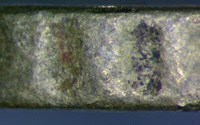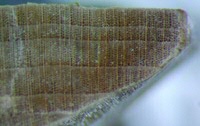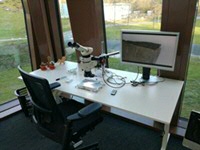Hooray, a Microscope!

Radiocarbon analysis of single tree-rings is booming. Occasionally, such analysis allows objects to be dated as precise as at the exact calendar year! But sampling single tree-rings is not easy. One needs knowledge of the growth of the wood species and to have the right sampling tools. And patience. But a first requirement is having suitable equipment. In this blog I briefly explain my quest for a good microscope.
In terms of wood sampling, our team started with the relatively easy stuff. We analysed numerous rings in known-age wood from dendrochronological archives. Often, these tree-rings had already kindly been split by one of our partner dendrochronologists. In the other cases, these wood experts had provided us a piece of wood with a carefully prepared surface on which the calendrical ages were clearly marked for every tenth growth-ring. And when we were lucky, the wood contained unambiguous, fat rings. We measured the radiocarbon content of such known-age wood for instance in search for new radiocarbon spikes, as part of a laboratory intercomparison, to contribute to calibration issues, and to investigate characteristics of solar storms.
But today I face a different reality. As Mike wrote recently, I use individual tree-rings for radiocarbon dating wooden artefacts at a very high precision. For various reasons, such archaeological samples could not be dated by means of dendrochronology. Sampling individual growth-rings from an archaeological piece of wood is less straightforward than the wood we receive from dendrochronological archives. The archaeological wood samples can be tiny and fragile. Also, they may arrive in a form which is far from an ideal cross section (or ‘cookie’) of the original tree trunk. Therefore, sometimes I have to use the radial or tangential section as the basis for identifying and splitting the individual rings instead of the transversal section. For such samples, it may be challenging to identify the waney edge (last growth ring), any ‘missing rings’, distinguish between early and late wood. Let alone to separate individual rings. Especially when I deal with slowly-growing wood species, with five years of growth represented in 1 mm. I may devote another blog about these challenges sometime.
Thus, I need a good microscope. I found one in Amersfoort at Stichting Ring, where dendrochronologist Petra Doeve gave me the necessary training in preparing and sampling different wood species. Here, I learned that a suitable microscope must meet the following:
- Magnification of at least 80 times. This is necessary to visualise the cell structure and to distinguish the change from one ring to the next.
- Enough working space (~12 cm). You need to be able to handle a scalpel, razorblade and tweezers between the lens/light source and the object.
- Good light source. This is important for the contrast. Some light sources are yellowish whilst others are blueish. Today, one can use LED lights that are very convenient.
- Camera function. Not necessary but very useful. Having clear reference pictures of the rings from before sampling is essential. Further, taking pictures during the sampling process can be valuable. Otherwise, you have to take picture through the ocular with a camera.

Thanks to a tip from Arnoud Maurer, an archaeobotanist who works at the Groningen Institute of Archaeology, I found the very handy store ABRO at Zaandam (close to Amsterdam). It’s an amazing store, situated in a dodgy garage. But upon entering the shop, you find an enthusiastic and specialised seller in a room full of a wide array of microscopes and accessories from different brands. The microscopes are in good condition but since they come from exhibitions they may have some signs of use. Therefore, the prices are pretty low, which is convenient if you want to spend your research money wisely.

For ECHOES, I bought a Leica M80 stereomicroscope. It includes an Eakins 34 MP camera, which is directly connected to my desktop. The microscope is placed on a Euromex adjustable, metal foot. This way I can switch easily between analysing a small sample and an entire object, while ensuring enough working space.

The microscope is now installed in my office. Instead of going by train to Amersfoort, all I have to do is moving my chair one meter. I am looking forward to start analysing new wood samples!
About the author

Link: /staff/m.kuitems/

